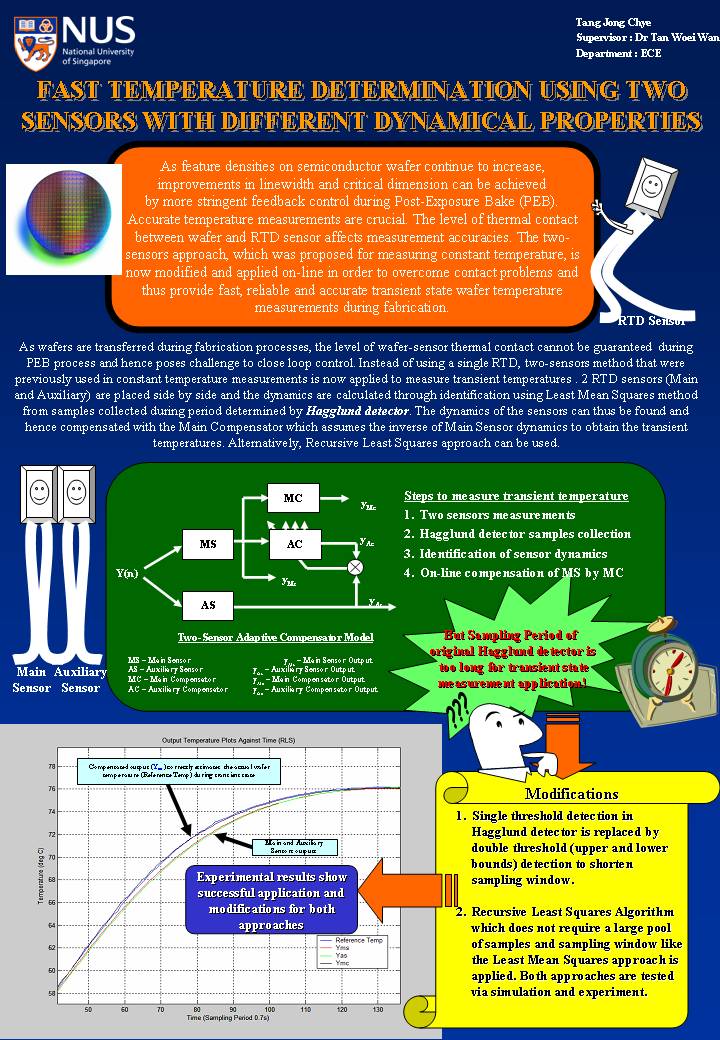| EE4001 Projects (Academic Year 05/06) | |
|
|
A NFC-based intelligent diabetes management system |
|
|
A fuzzy classifier for cardiologic auscultation |
|
|
A fuzzy approach for assessing significance of missense mutations in disease genes |
|
|
Adaptive Type-2 Fuzzy Controller |
|
|
SPAM filtering using fuzzy theory |
| A NFC-based intelligent diabetes management system | |
| Seah Yew Keng and Tan Ting Feng | |
| 1st Prize, Philips Young Innovators Challenge 2006 | |
|
Evolving from a combination of contactless
identification and networking technologies, Near Field
Communication (NFC) is a wireless connectivity technology that
enables convenient short-range communication between electronic
devices. It offers the ultimate in convenience for connecting
all types of consumer devices by enabling rapid and easy
communications. In our increasingly complex and connected word,
NFC provides a solution for controlling data. |
|
| A fuzzy classifier for cardiologic auscultation | |
| Foo Chek Liang | |
|
A heart murmur is an extra heart sound in addition to the two heart sounds normally heard with each heartbeat. Innocent heart murmurs are of no clinical consequence but pathologic heart murmurs indicate congenital heart disease is present. When a heart murmur is detected during auscultation (listening to the heart through a stethoscope), the clinician has to assess the murmur qualitatively to differentiate between innocent and pathelogic heart murmurs. Such auscultatory skills can only be accumulated by exposure to a sizeable murmur population and maintained through constant practice. Hence, doubt as to the nature of the heart murmur may still exist after auscultation in many cases and patients are further tested using advanced imaging techniques that are expensive. A more screening device will help to reduce unnecessary testing, thereby helping to reduce health care costs. This project aims at developing a fuzzy classifier to assist a clinician in determining whether the heart murmur is innocent or pathelogic. |
|
| A fuzzy approach for assessing significance of missense mutations in disease genes | |
| Lee Kunfeng, Daniel | |
|
Identification of deleterious mutations within candidate gene provides a means for detecting disease. One approach is to try to infer structural change asociated with mutations and draw conclusions regarding their deleterious character. However, the significance of any base or amino acid change within a gene is unknown until detailed structural and functional analysis has been carried out. Another, potentially rapid, way of finding functionally important sites within a gene is to identify evolutionarily conserved regions. Mutations affecting such sites are assumed to be deleterious for the carrier. This project seeks to develop a fuzzy approach for predicting whether specific mutation is deleterious given sequence data from a set of homologues. |
|
| Adaptive type-2 fuzzy controller | |
| Kwa Lip Oon | |
| Membership functions of standard (type-1) fuzzy sets are usually represented by the Guassian function. The mean and standard deviation of the Guassian function are frequently determined by 'learning' algorithms. One example is the Adaptive Network Based Fuzzy Inferencing System (ANFIS), which has successfully been applied to a variety of applications. Recently, there is more and more interest in type-2 fuzzy sets because they present a better representation of the 'fuzziness'. Type-2 fuzzy logic systems also provide better modelling accuracy with a smaller rule base. In view of the advantages offered by type-2 fuzzy sets, this project seeks to extend the learning algorithms for adapting a type-1 fuzzy controller to its type-2 counterpart. | |
| SPAM filtering using fuzzy theory | |
| Fun Seong Ngee | |
|
SPAM is an unsolicited automated email. It is any message, regardless of it's content, that is sent to multiple recepient who do not specifically requested the mail. The amount of such unsolicited commercial email or "junk mail" showing up in an email box is growing. SPAM filtering is a method to combat this problem. The role of the filter is to distinguish SPAM from HAM, the innocent mails, without any false positive (false positive mail is an innocent mail which is considered as Spam even though it is not). This project aims at utilising fuzzy set theory to implement a "Spam Filter". |
|
| Current Projects |
| Click on poster for details |

